What is the process for painting miniatures competitively? Or, how do professional miniature painters, well, paint? As with any artistic endeavor, every individual has a unique approach and style. The miniature painting hobby is awesome because it has an amazing community of artists, gamers, and teachers. Whether you’re a tabletop gamer, e.g., wargames or board games, or simply love the hobby aspect of painting miniatures and models, we can all learn from engaging with one another. I’ve formed friendships that would not have happened if it weren’t for the miniature hobby aspect of tabletop gaming.
In this article, I share a conversation I had with Marike Reimer, an award-winning professional miniature painter, about her process in painting the “Kraken Mistress”. The Kraken Mistress won the Crystal Brush $10,000 Prize at Adepticon in 2014. To see more of Marike’s incredible work please visit her website at destroyerminis.com.
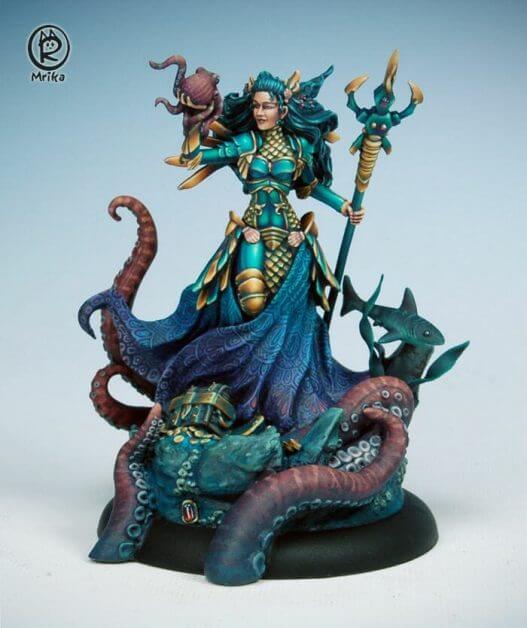
Marike Reimer has won numerous other miniature painting contests, and has worked for renown miniature studios, including: Crocodile Games, Darksword Miniatures, Reaper Miniatures, and Freebooter.
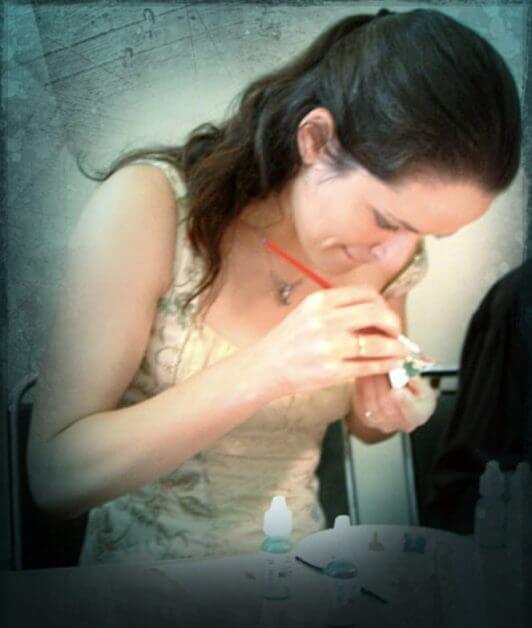
Here you’ll learn:
- Marike’s conceptual approach for painting miniatures
- Process for composing a miniature painting
- Her tools and techniques
- Other unique tips and insights
Continue reading to learn more from Marike Reimer, her thoughts and process for painting the “Kraken Mistress”, a Crystal Brush award winning painted miniature.
Side note: I’ve organized this write-up in the best way I can based on our informal chat. You can see my additional notes in the gray boxes. I hope you find this article engaging and informative!
What do you say to people who are intimidated about the process of painting miniatures?
I’ve had people ask for feedback on partially finished miniatures. It’s often hard to critique models that aren’t done, or guide someone toward a finished product. My advice to them is to get comfortable with the process that your painting will look bad on the way. For example, if you are placing a color to see if it looks good, don’t spend a lot of time making the blend perfect until you are satisfied with the overall composition. It’s okay to have rough color transitions while you’re sketching out your idea.
There are “intermediate states” where your painting doesn’t look good at all. Keep going!
When did you start painting miniatures?
My start wasn’t so exciting. I came home from school and my roommates had a large battle, little blue guys, and little dinosaur/alien/bugs that I later learned were Tyranids from Warhammer 40k.
I thought to myself: Oh, cool, painted miniatures. What are these?
Ultimately, painting miniatures was more fun than the tabletop game.
How did you learn to paint?
I painted when I was a little kid. I learned on my own for a while. It was around Gen Con in 2002 that I really picked up on painting miniatures. At Gen Con, there are painting table booths setup. There people showcase their work and demo how to paint miniatures.
Here I met Anne Foerster (another multi award-winning miniature painter). She showed me the ropes. Anne showed me a demo of the blending and layering technique with acrylic paint.
Then I saw Jennifer Haley and her work, and I was “absolutely blown away”. This was the start….
What are your favored brushes and palettes?
For most of my blending and layering, I like cheap nylon brushes that are fairly stiff. Reaper Miniatures used to make my favorite nylons, however they discontinued them and I have yet to find a replacement.
In general, I recommend spending only $4-7 on a nylon brush. After too much money, brushes tend to be too soft bristled. I use a small Jack Richeson ceramic palette. I don’t use a wet palette.
For fine detail work, I use Kolinsky sable and have begun breaking in a size #0 Rosemary and Company brush.
What techniques do you use for blending acrylic color?
I use a variety of techniques. I sometimes start with loaded-brush blending for smoothing the transitions between layers of color. Loaded brush blending is when I need to blend two colors on a miniature. My brush has two colors of wet paint on it, the mini has the same two colors dry, and gently pulling the brush perpendicular to the bristles blends the two colors. I try to use a smooth stroke without going back and forth, which leaves jagged lines. Blending is followed by glazing to get transitions smoother.
Also, I do spit blending (also known as two brush blending) – substituting water for spit. I find that it is faster and easier to rinse one brush than to keep track of the second one.
For glazing, I use a nylon stiff bristle brush. For brush size, I use #0-003 pointed round nylon brushes. Lately, I have been playing around with flat-headed brushes, but haven’t formed any preferences.
You can learn more details about how Marike uses her tools, brushes, and techniques below.
How long does it take you to paint a model?
It depends on the size and what I want to do with it. For studio paint jobs (for the miniature companies), I would spend about 8-20 hours on a miniature painting.
For a competition paint job, I would spend about 40-60 hours on a model. Models are about 2″ tall, generally.
I enjoy speed painting contests where you have an hour to paint a miniature.
Color theory: what are your thoughts on color?
I like teal and purple, because they look really nice together. I’m drawn to these colors. Some might call it a rut, however lately I’ve been getting out of it with full-spectrum pieces, which is a departure from the more traditional color triads.
I also like to use references from gaming art. Like I’ll use Magic the Gathering cards as color references and World of Warcraft art as inspiration for choosing colors.
How Marike Reimer Painted the “Kraken Mistress”, an Award Winning Miniature
Marike went into this project knowing she would enter this into the Crystal Brush competition. Ultimately, the project won the top Crystal Brush prize at Adepticon in 2014. The sculpt was a collaborative effort between Dark Sword Miniatures’ creative contributors. Marike’s resemblance is sculpted into the Kraken Mistress.
The concept art for the miniature sculpt was done by Izzy Collier. Jeff Grace sculpted the actual miniature.

During the design phase, Izzy talked with me about the concept art for the sculpt. As part of this discussion, I contributed a photo of an octopus on a hand (which became part of the final sculpt). I also wanted armor on the model so I could do non-metallic metal (NMM), and flowy elements for me to add freehand elements.
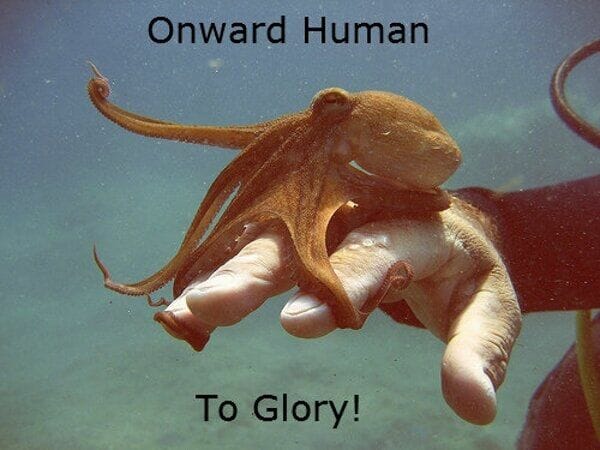
After I received the sculpt, I added tentacles and other bits with Green Stuff, a sculpting epoxy, based off Izzy’s concept art (not shown here).
Model preparation
To make sure I don’t get fingerprints on a model, I pop off the sculpt from its base. I then attach the model to a painting handle. Usually, it’s the cap of a spray can.
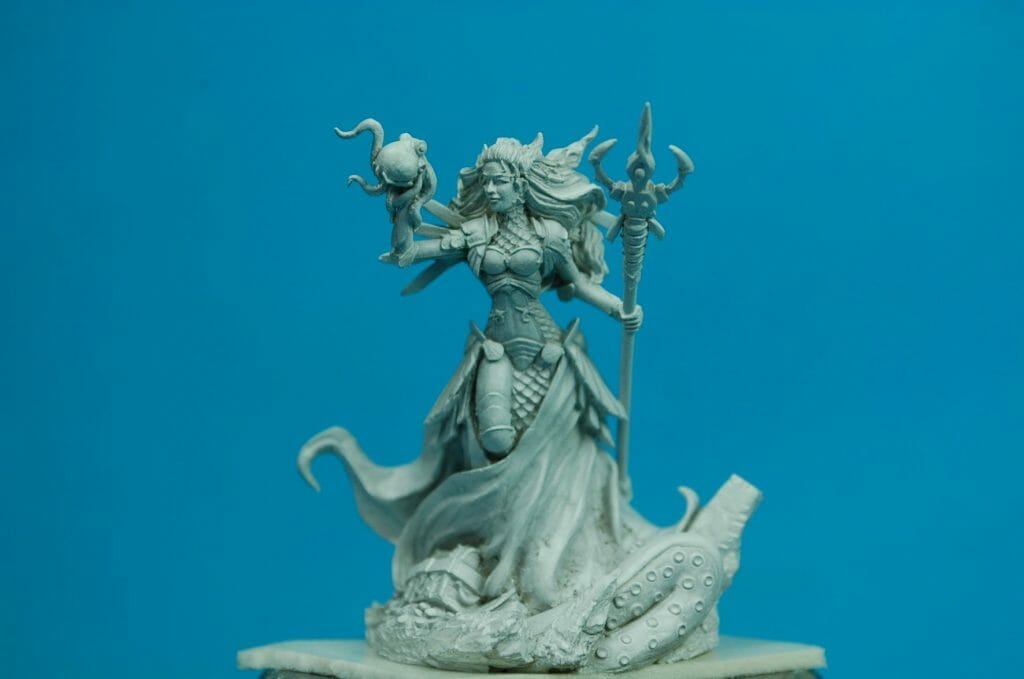
I prime the model after assembly and use a white Tamiya spray primer. Make sure to keep the nozzle more than 6″ from the model, spraying in light thin coats.
RELATED: BEST PRIMERS FOR PAINTING MINIATURES
Make sure your spray can nozzle isn’t clogged. I will spray the primer on a piece of cardboard first to make sure the primer isn’t fuzzy, gritty, or clumpy.
“Always test your primer first on a different surface than your model.”
Do the same with your varnishes and sealers, because they can potentially turn white or frosty. Test on a different surface, always.
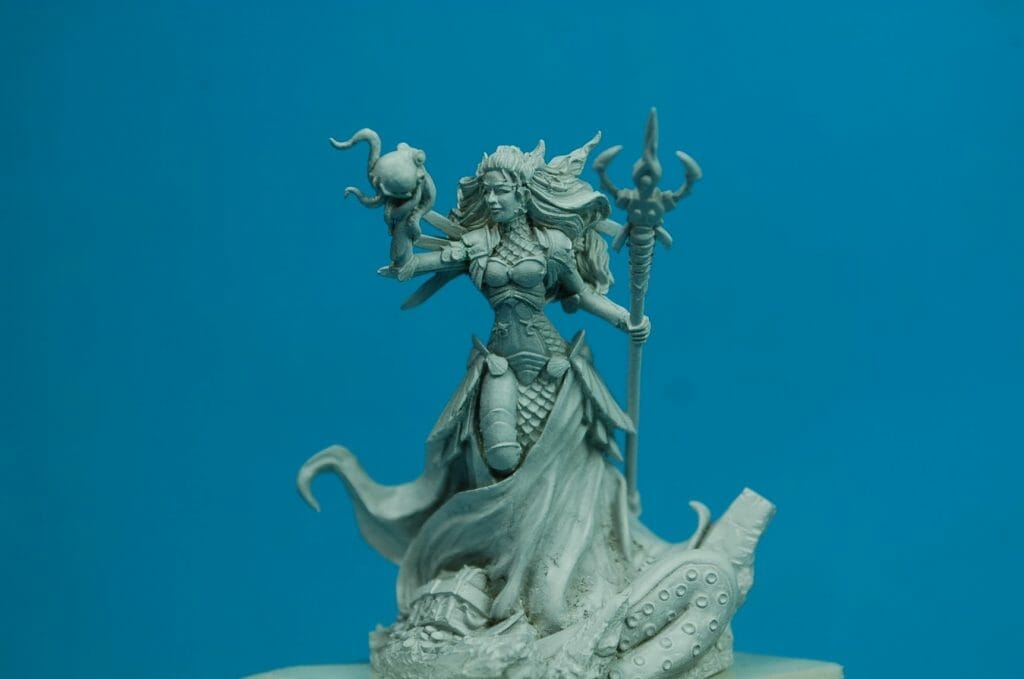
Planning out the color scheme
To plan out the colors I want on a miniature, I will take a photo of the primed miniature and print it out. Then, I’ll paint acrylic colors directly on the paper printout.
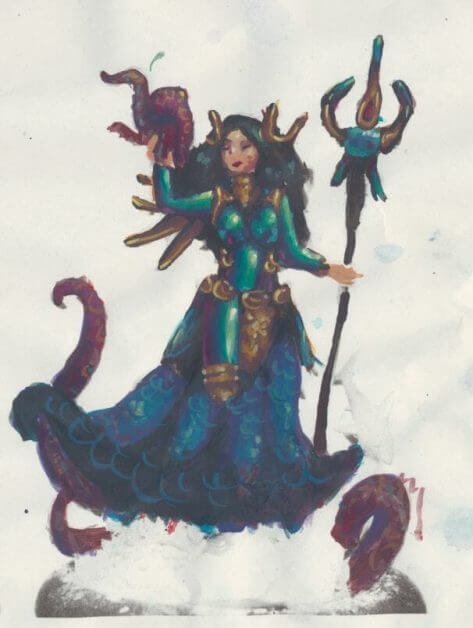
This color palette uses the same paint I would apply to the model.
My preferred acrylic model paint is Vallejo Model Color. It is the paint brand I use most because it produces a nice smooth texture that makes blending much easier.
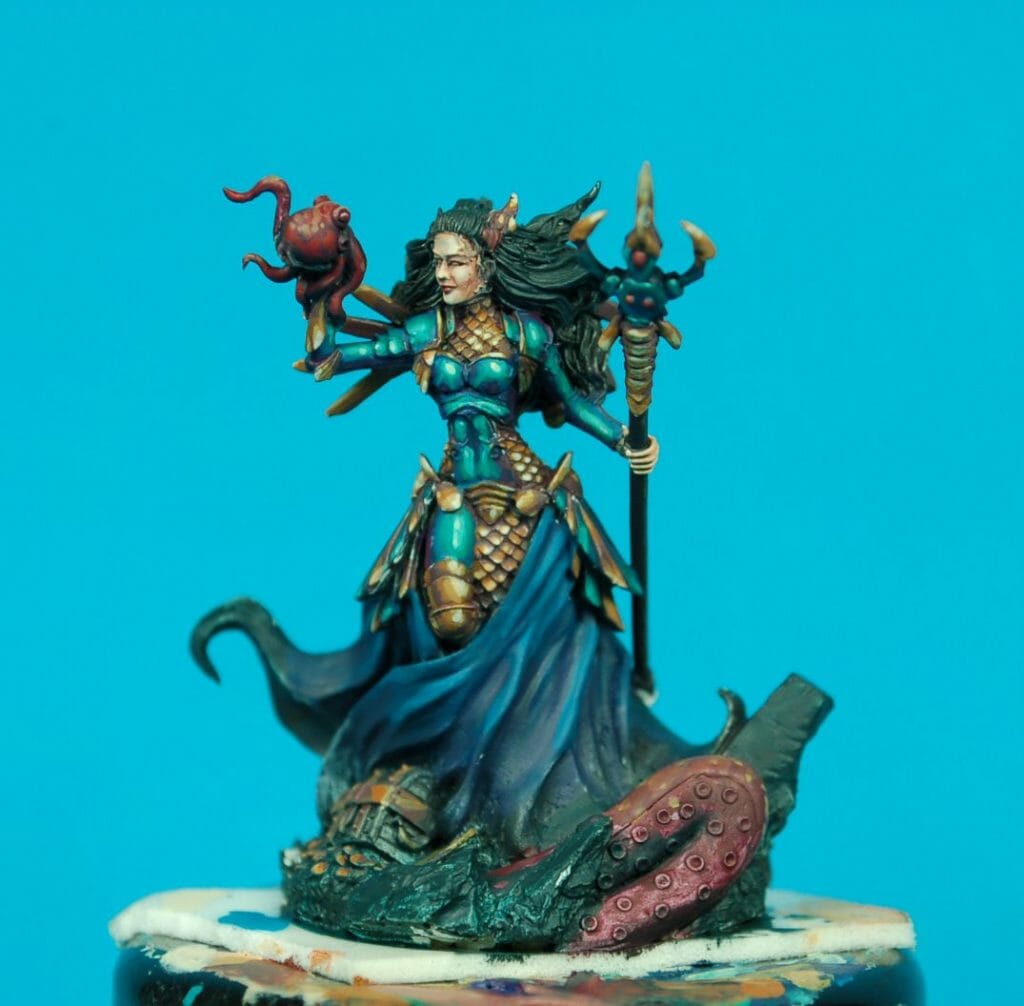
Where do you start painting first?
I paint everything that is hard to reach with the darkest color in the piece. For the Kraken Mistress, I used the base hair-color (Vallejo Dark Sea Blue) and applied in all the recesses.
I hate seeing white primer, so I try and get rid of it as quick as possible.
Visually, it is more work to use black primer. Details are harder to see and paint if I start with a black primer and I find it adds a little more eye strain than white primer. White primer is easier to see details when I want to paint to a higher standard. Primer choice depends on context.
“My heart dies a little when I’m handed a model to speed paint with white primer on it…”
Marike Reimer.
Base coating or “blocking in” color
After the model’s recesses are painted in, I block out all the other colors to get an opaque layer down. I block in (or base coat) color until no white primer is showing through.
I use fairly thick paint for this.
Using the paper sketch I did, I base in all the colors like a children’s “coloring book”.
“Think of this step like painting by numbers,”
Marike Reimer says, about base coating a model.
First steps to get the non-metallic metal (NMM) effect
For the NMM, I sort of sketch in the reflections with fairly opaque thick paint. There is a lot of NMM on the model.
I’m trying to get the sense of colors now. No real formula. No transitions, yet.
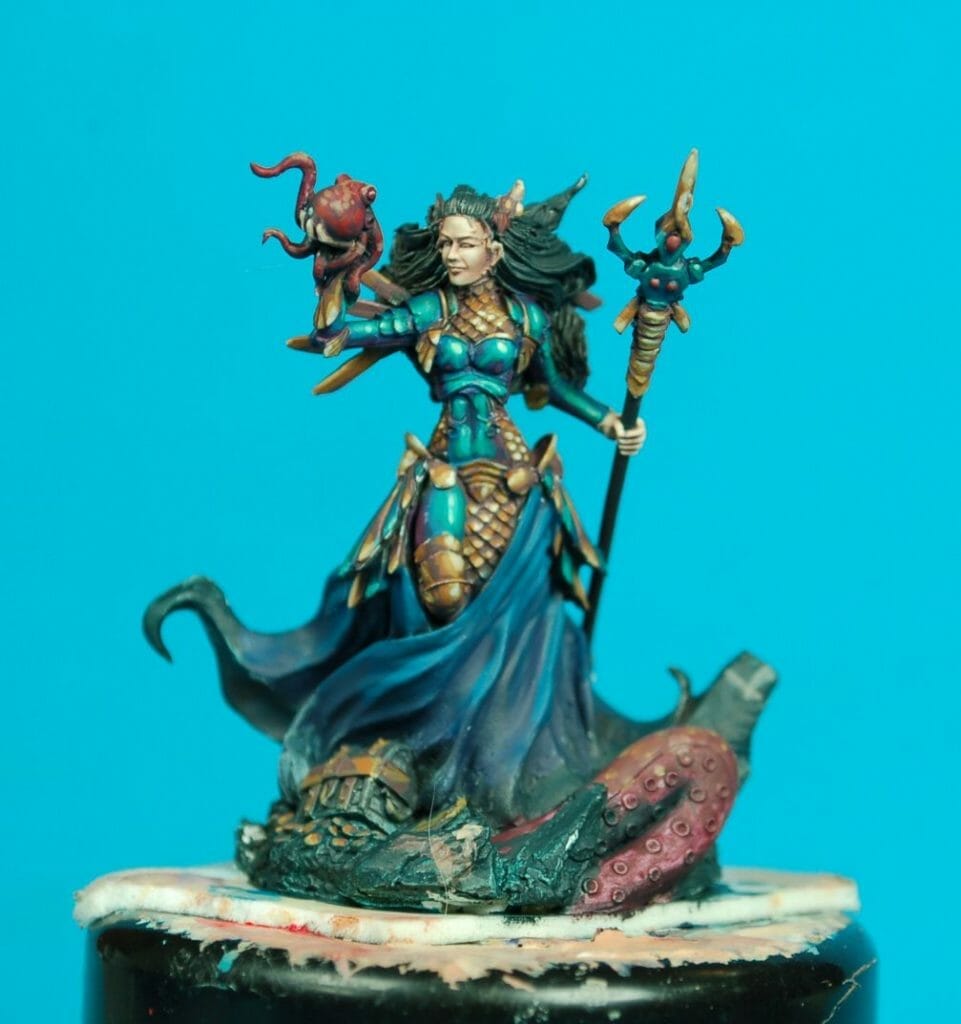
There is some blending on the fabric, but I’m not invested in blending, yet.
What is the “squint test” for non-metallic metal (NMM)?
At this point, if the model passes the “squint test”, I move on.
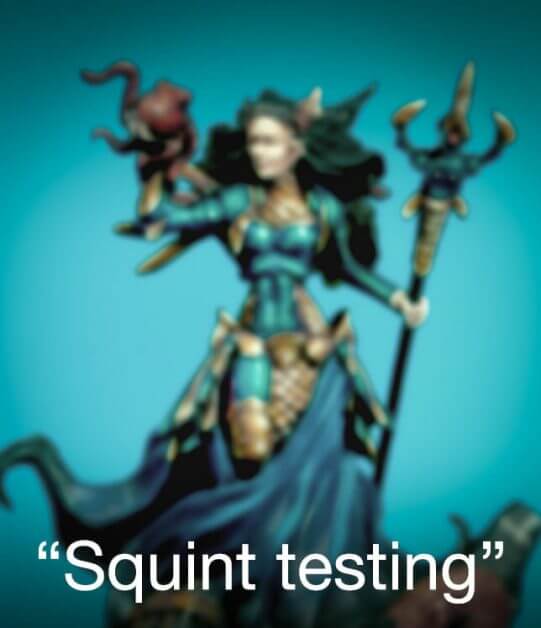
The squint test is how I determine if a metal surface I painted looks shiny. If I close my eyes a little bit, squinting through my eyelashes and the mini looks shiny, then I’m on the right track.
The squint test is a time-saver! You can waste a lot of time following a theory that doesn’t always work.
It is more satisfying and fun to put down color and squinting to see if it works as NMM, rather than follow a formula or theory for NMM.
If your model looks shiny with squinting, keep going!
READ MORE: WHAT IS NMM?
Wait, you use “old” brushes to paint details?
The face was painted mostly with a tinsy, tiny #000 pointed round nylon stiff bristled brush. I’ll switch to Winsor & Newton Series 7 Kolinsky sable brush for some finer details, e.g., eyes. Actually, I use a 5-year old size #0 miniature W&N Series 7 brush, which is worn down to a fine point.
I prefer using old worn down Kolinsky sables for competition pieces. The old Series 7 brushes get really good after 1-2 years of regular use. I rotate my brushes to keep them in various productive stages in their life cycle.
The bristles break off the tip, so you have a super sharp point over time, and this happens through regular wear and tear on my Kolinsky sables.
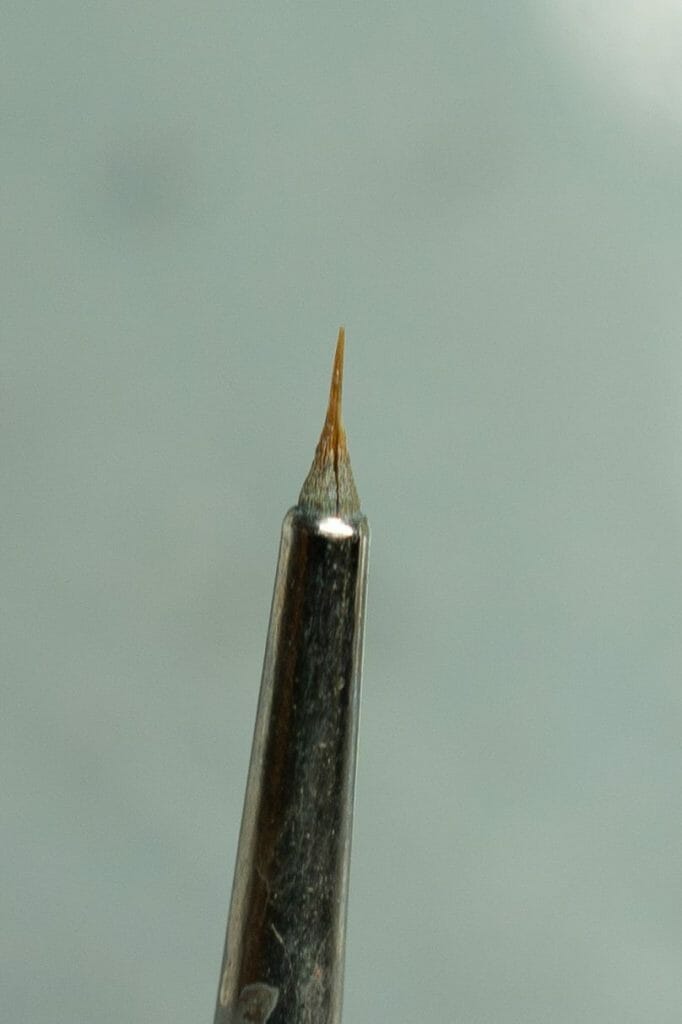
I’ve tried to accelerate the wear-down process on my Kolinsky sable brushes, including snipping off errant bristles. But, I can’t get as sharp a point as the brush maker’s did originally. I even tried to rub the brush on paper to wear down the bristles, but it felt like it was damaging the surface of the bristles.
Why Winsor & Newton Series 7 brushes and what size?
I use W/N Series 7 brushes because they wear down gradually, while maintaining their sharp point. I use these miniature hair Series 7 brushes, because they have a very triangular point and a big belly (a large capacity to hold paint), which increases the working time before the paint dries.
Any advice for brush handling for painting details on a miniature?
The longer the lever, the longer (more) vibration you’ll get in the bristles, which is why I don’t use the long hair brushes. A shorter point gives me more precision, so, I stick with short-haired brushes for painting details in my competitive pieces.
I hold the brush close to the bristles on the ferrule. I pinch the metal ferrule, and brace one hand on the spray can model holder.
She couldn’t show me, but from our discussion. Marike pinches the brush near the bristles on the ferrule, while bracing her painting hand against the spray can cap (which she uses as a model holder).
says Marike Reimer, as she talks about painting tiny details on a miniature.
Before I apply paint from my brush to a model, especially when painting fine details, I test the bristles first on another surface. Plan and test before you invest on an approach. Dab the tip of your wet brush on another surface before you touch it to your model.
Painting the face and eyes
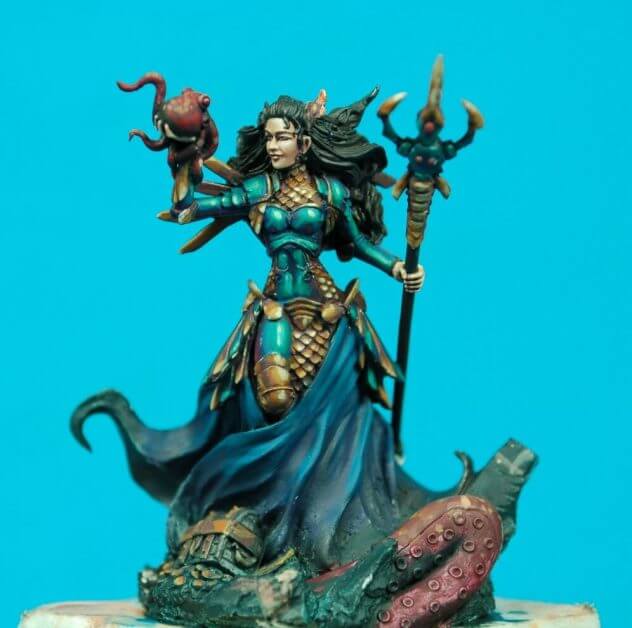
I get some shading on her face. The base skin tone is usually something fleshy, pinkish. For shadow, I start with a darker shade. For this model’s face shadow, I mixed some Vallejo Oxford Blue and Dark Sea Green, and added this to the base flesh tone.
I’ll also add some ruddiness, reddish tones into the shadows. I do this by placing this reddish color in between the mid-tone and darker shadows. This is an accent or kick color.
For painting eyes, I use a small kolinsky sable size #0 (a 5-7 year old brush) that is a really sharp Kolinsky that holds paint and releases it reliably. You can see my tutorial for painting eyes on my blog.
Test the paint release on a nearby surface before hitting the eyes. Get really close and brace yourself. On this model, I tapped the brush against the hair on the model (which is unfinished) to make sure the paint is perfectly consistent and does what I need it to do before touching the bristle tip to the eyeballs.
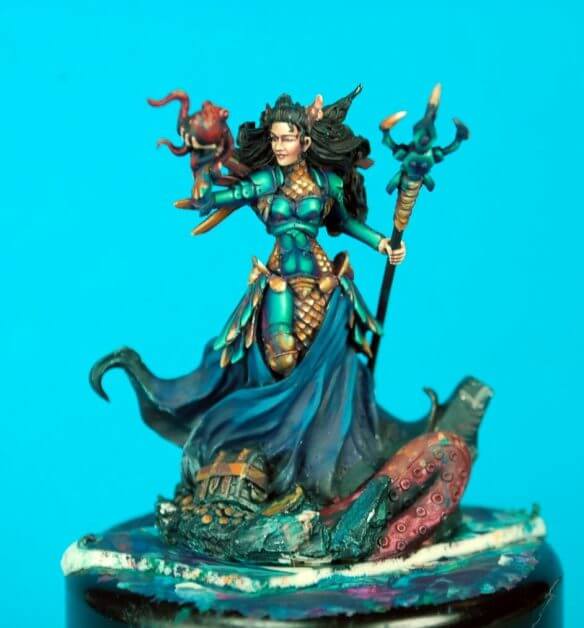
What if you make a mistake at this point?
If I make a mistake painting details, like eyes, I’ll try and wipe off the paint quickly.
First, I’ll try paint cup water. It’s the fastest.
If water doesn’t work, I’ll use saliva. It has enzymes in it. I lick a finger to deposit the saliva and then use a nylon brush to gently erase the errant paint, while trying not to lift up any underlying paint.
RELATED: REASONS WHY SALIVA IS GOOD FOR YOUR BRUSHES
A last resort if all else fails is to use soapy water…

All the photos I took here are taken with a Nikon D50 and kit lens, says Marike.
Tips for painting and blending color on the armor plates
I smoothed the armor at this stage. The NMM passed the squint test and I didn’t do the highlights, yet, focusing on the shadows and midtones for the most part.
I blended the transitions on the armor with a variety of techniques: glazing, spit-blending, and loaded brush blending.
For blending, I paint from midtones to shadows; then, midtones to highlights.
She also basecoats first with the midtone color. See above about “blocking-in” color.
For the gold metal surfaces (NMM-style), I washed with a dark turquoise. To make this wash, I added water to normal turquoise model acrylic paint (Vallejo Turquoise). I make the ratio of the wash by feel.
“If you paint a wash over a barcode, you should still be able to scan it,”
Marike Reimer
READ MORE: TOP 3 WEBSITES FOR HOW TO PAINT NMM
More insights for painting the NMM gold armor
Here are a few more tips into how I painted the gold armor using NMM techniques.
My gold NMM recipe uses Vallejo Model Color:
- Mahogany brown (reddish color in darker shade)
- Orange brown (the main orange color in the metal)
- Yellow (most of the highlights)
- Pale sand (brighter highlights)
- Turquoise used as a wash in the shadows
I use the Model Color Turquoise wash near the end of the NMM gold. Some of the Turquoise is glazed (instead of washed) to control where it goes.
Then, I bring back some of the lost highlights after this wash.
“Paint underneath things first.”
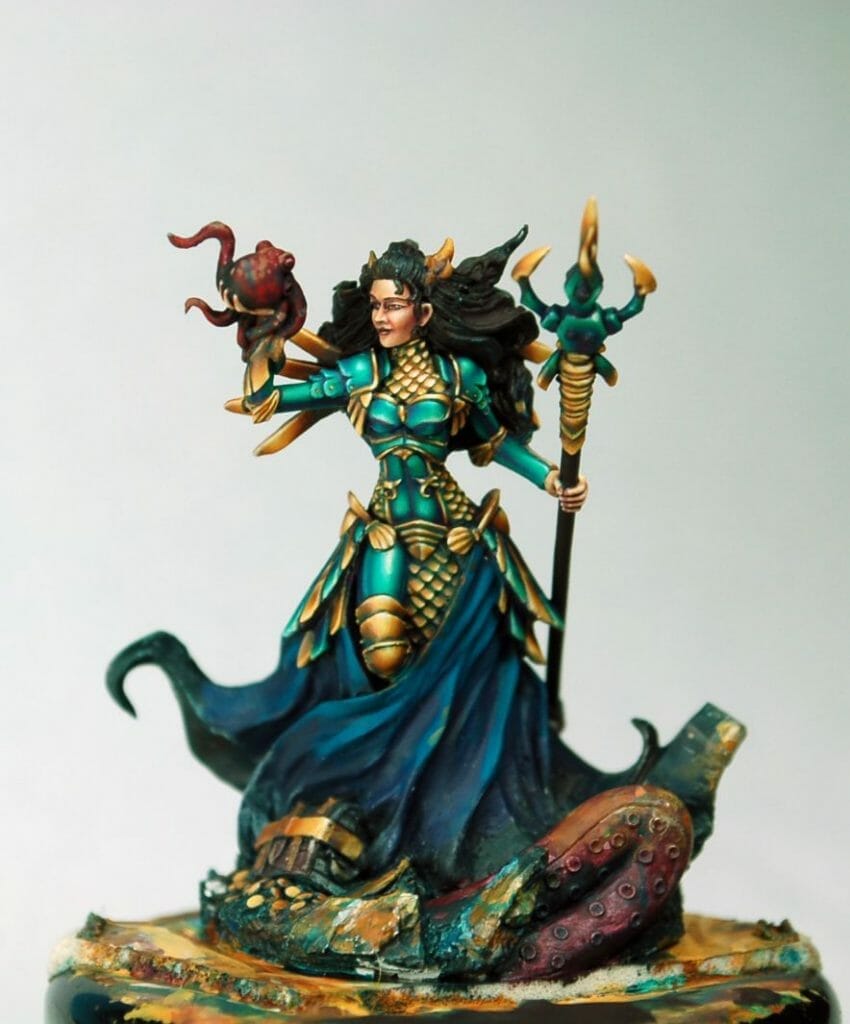
What brushes do you use for NMM painting?
The paint brush I use for the highlight detail work is the Kolinsky sable (see above about brushes).
The workhorse brush of course are the nylon brushes. I also prefer nylon brushes that are “stubby”, not sharp and pointy. With a stubby tipped brush, it is easier for me to predict how the brush acts.
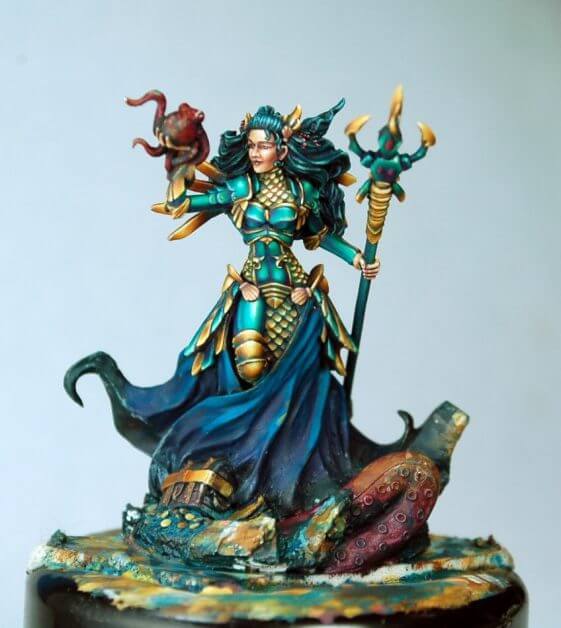
What did you do to paint the hair and seashells?
My tip for early steps in painting is to “paint underneath things first”, if you can.
For the hair, the seashells are on top.
So, in this case, I painted the hair first.
Hair is a simple highlight on top of the base. The hair sculpt already has nice raised texture to it. So, I painted a mid-tone grayish color on the raised areas, and kept subsequent highlights fairly narrow and tight.
For the highlight colors, I mixed the base-tone of the hair with a little blue gray, and some sort of blue whiteish yellow. For the darker parts of the hair, I left the highlights in a narrowly defined band, which makes it look shiny.
The brightest color is not pure white.
The only part of the model that I used pure white are the specular highlights in her eyes.
For the seashells in her hair and waist, I did a simple layering up to highlights from the base color.
How did you do the free hand designs on the cloak?
I didn’t really plan it out first and had to experiment to get through a design block.
The brush I used was a size #000 nylon brush. I sketched the mid-tone color of the cape to get an approximate idea of what I wanted to paint. I started with paint applied on the top of the cloak, and free hand my way down the cloak until I got sick of it.
The consistency of the paint on the brush is a little thinner than a base coat (e.g., thicker than a glaze), because I didn’t want to deposit too much pigment.
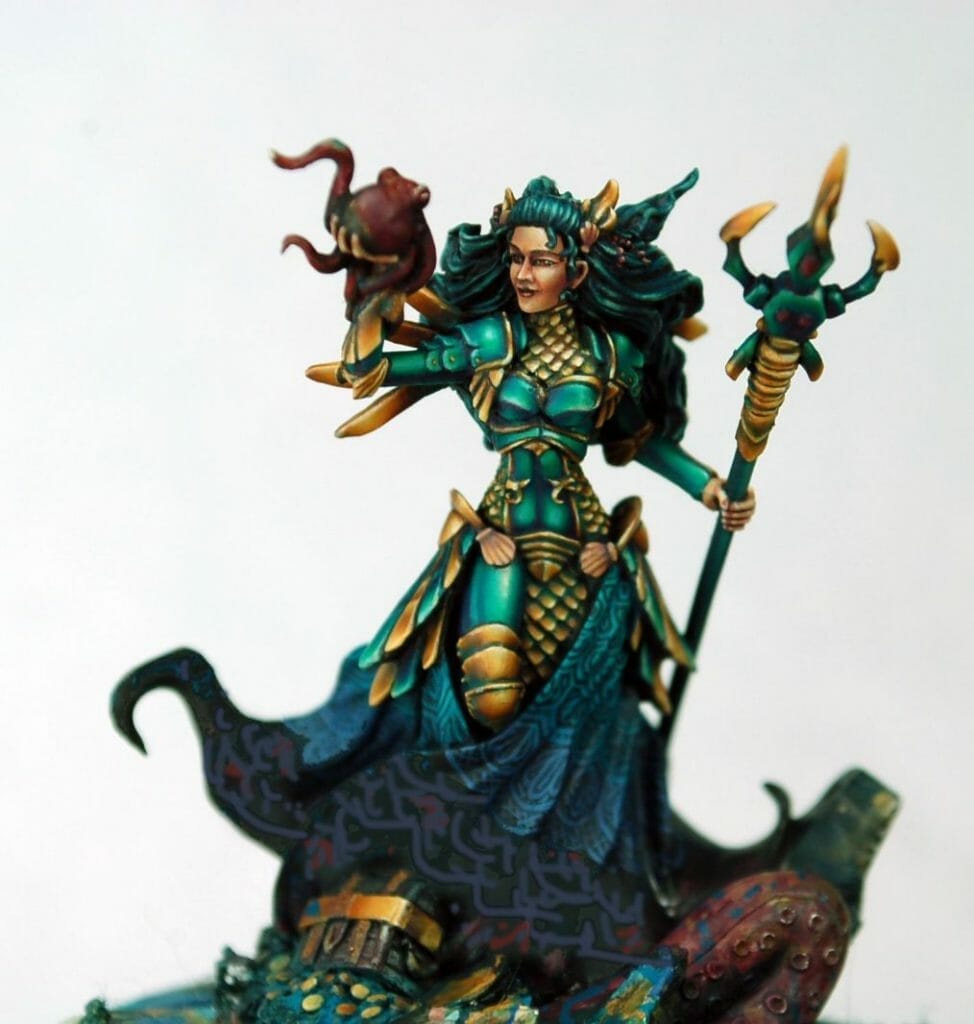
Then, I took a picture of the model (the work in progress), and put the photo into the Procreate App on my iPad. This way I could see how it might look as I paint down the rest of the cape. Sometimes when I decide I want to freehand, I sometimes sketch out the design in advance on paper. In this case, I didn’t do that.
Check out the photos below.
Looks like you got stuck?
As I went, of course, I messed up a little on the free handing. Although the free hand design at the top of the skirt is working, i.e., I refined it a lot, I got stuck as I went down the cloak.
I wasn’t sure how to expand the design through the entire skirt.
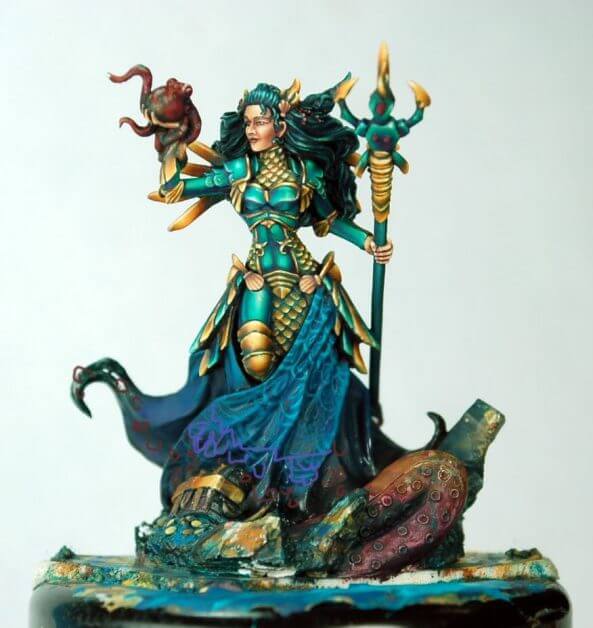
That is why I kept sketching digitally in Procreate to figure out how to make it work. After doodling, I came up with something that worked, which was the Kraken Mistress you see in the image below.
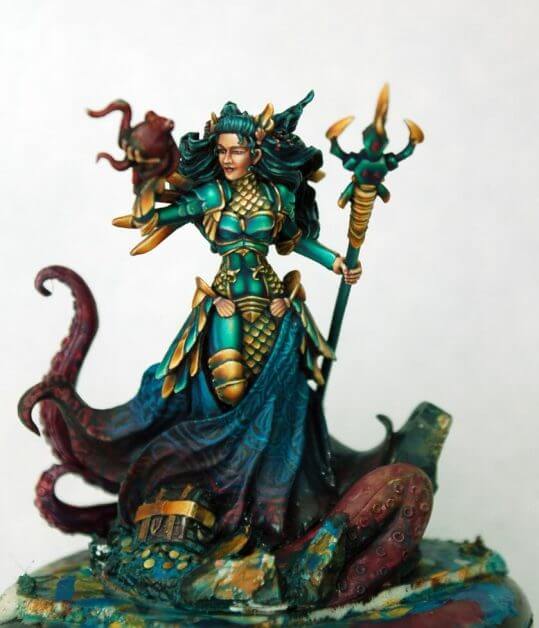
Eventually, I got something that I thought worked. And, I fleshed it out.

The idea was to get the quick and dirty blends with the mid-tones and shadows on the skirt painted on first (on the lower part).
Then, I painted the freehand design over this mid-tone/shadow area.
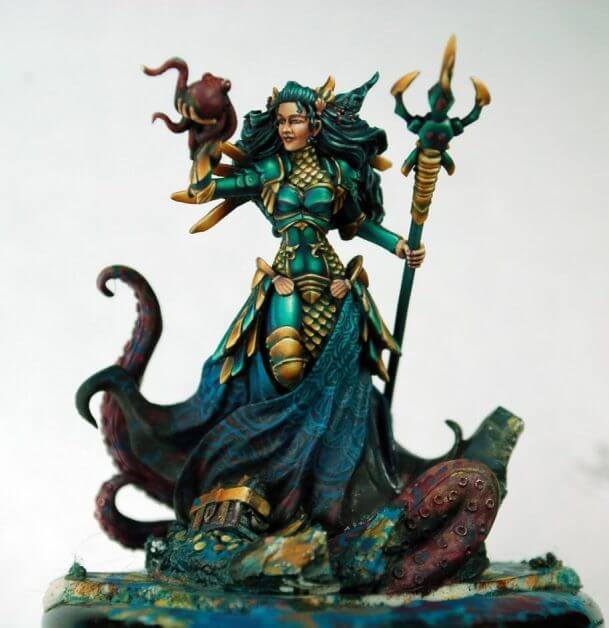
It looks a bit too blocky at this point. So, I keep refining. I noticed at this point that I wanted a transition on the skirt which connected the blue to the Octopus color motif.
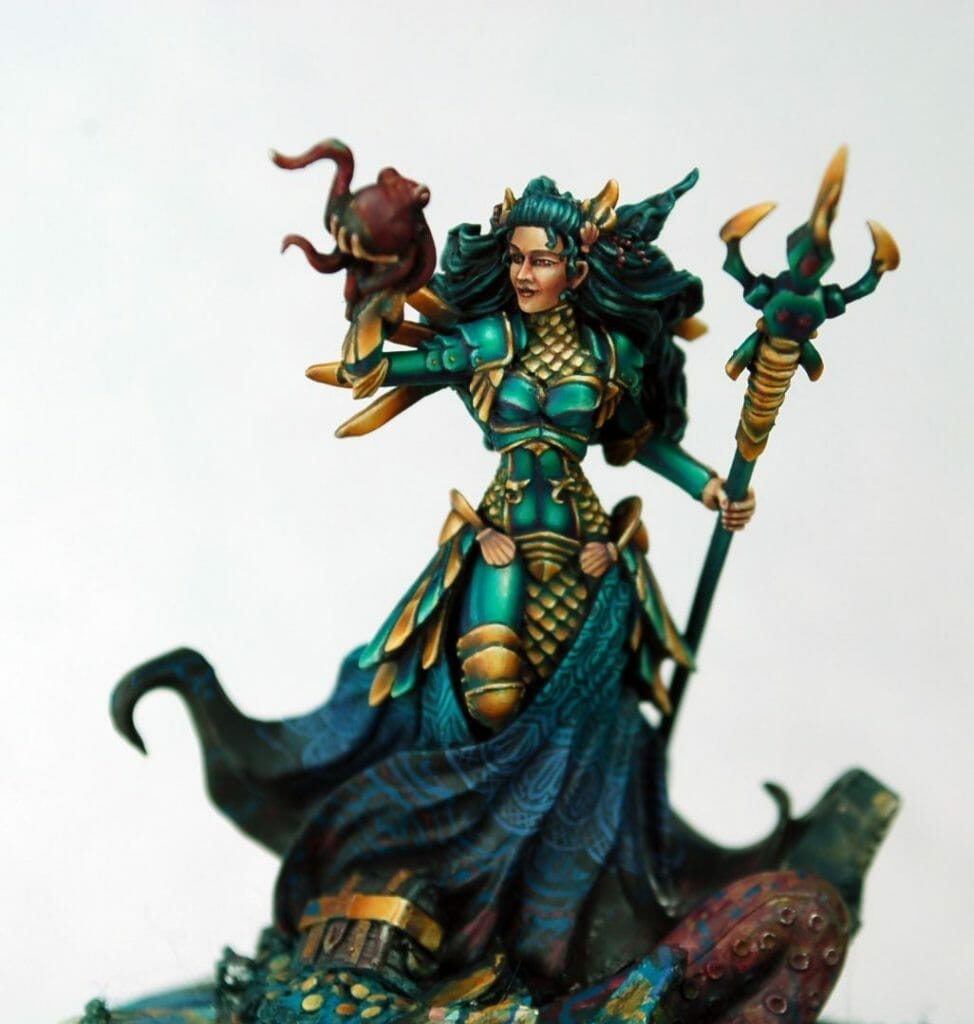
I blended the free hand directly. No washes/glazes over the cloak.

I spent a lot of time making sure brush strokes don’t show up on my freehand design. I go in with my trusty old Kolinsky sable brush and clean up any lining that isn’t perfectly clean.

The octopus….changed?
You’ll notice that I changed my mind about the texture on the octopus she’s holding in her right hand.
I fleshed out the colors on the octopus, repainting the design here. You’ll notice that the blue rings are gone, now from the octopus.
I also painted the gems on her staff at this stage, and played around with “seaweed” ribbons around her staff.

I’m experimenting along the entire way.
Trial and error through the entire piece.
Reattached the sculpt to the base….
So, she’s back on her base. I use super glue for basing. Nothing fancy.
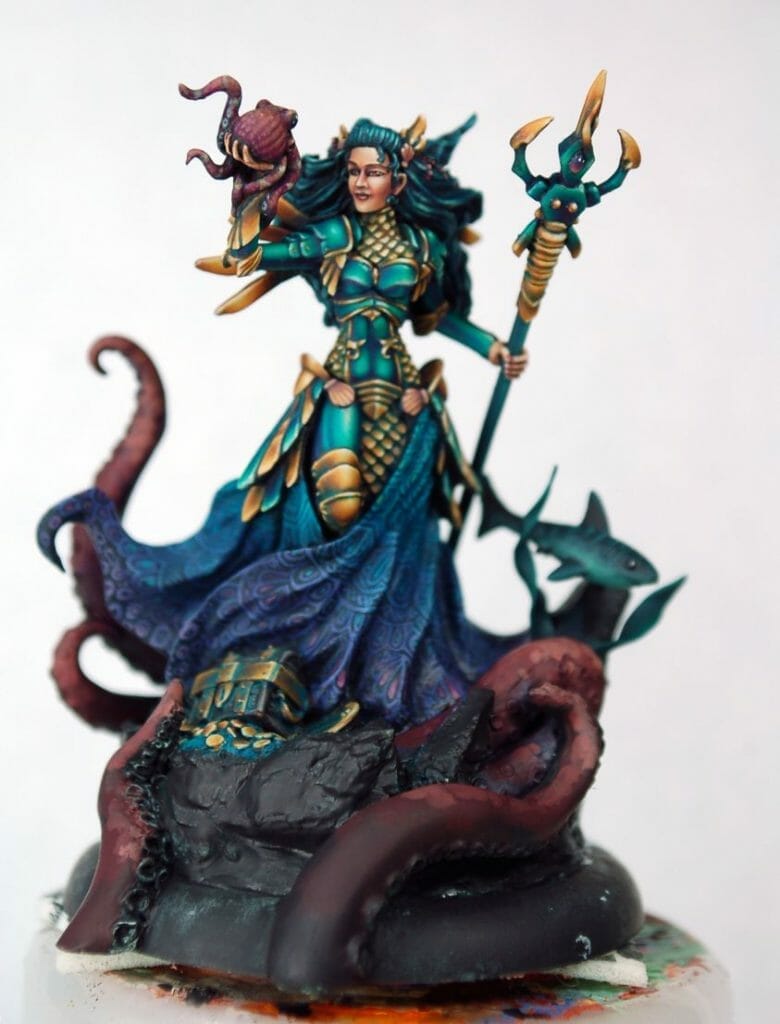
I free handed the fleshy textures on the tentacles. And, the shark, too (in the back).
The orange in the image above is digitally drawn in using Procreate. But, I ended up not using that bright orange.
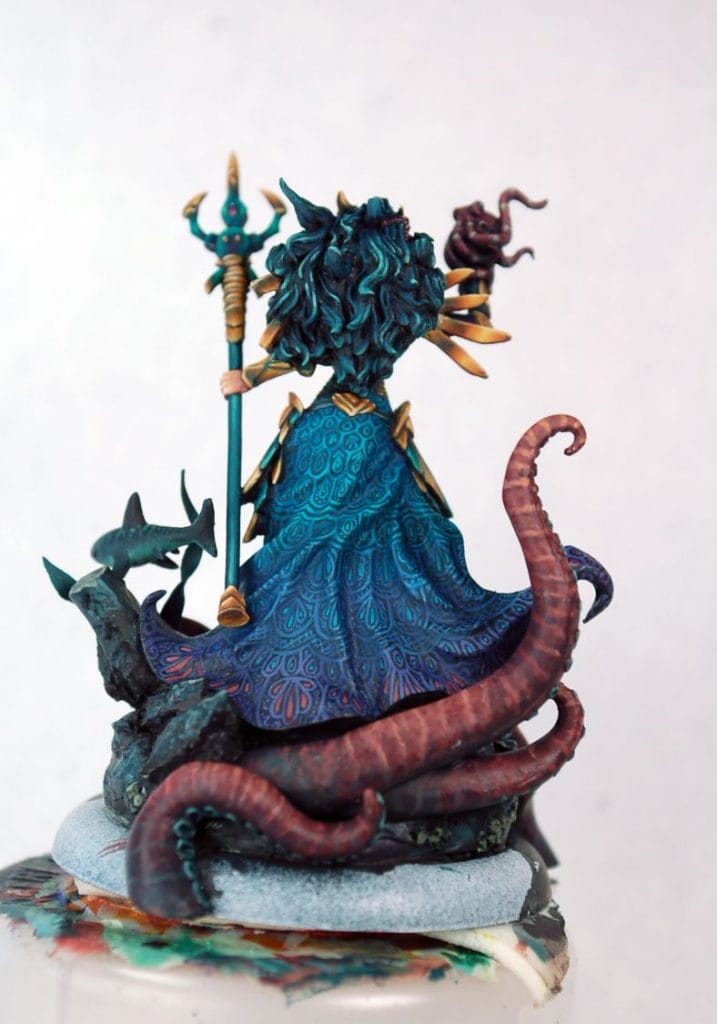
From the back, it took me a very long time to make everything smooth.
From the back, it took me a very long time to make everything smooth; the cape, the tentacles, the NMM.
Lots and lots of glazing. Lots of clean up on the line work on the skirt. This part took up a pretty good chunk of the total time to paint the model.

Using photography to critique progress
Along the way I took a lot of photos to help me see what’s missing.
RELATED READING: USING PHOTOGRAPHY TO HELP PAINT MINIATURES
Photos also let me show others to help me with the painting composition. I share the photos for critiquing my work.
Des Hanley (a former illustrator and artist for Games Workshop) said a red gem was needed on the rock on her base to fill a void in the arc of red which starts at the octopus. You can see the rock is bare in the image below.

So, I added the gem, which you can see below.

This gem really added the extra point of interest in the composition. The feedback I got from others was critical to the overall success of the piece.
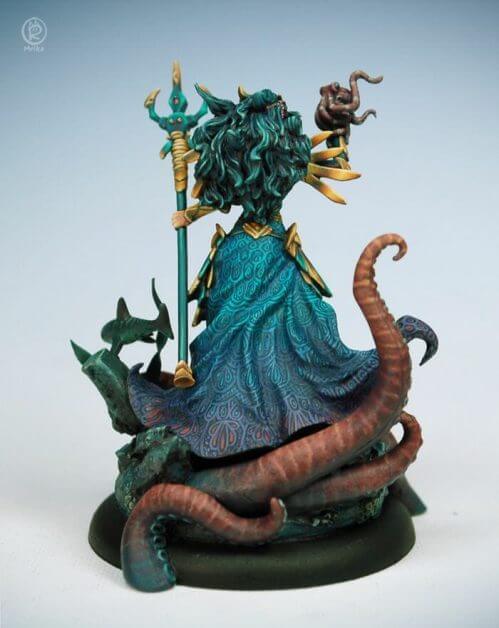
The final images aren’t the greatest for showing off the colors on the actual model. Highlights and contrast are actually brighter than this. The model is completed at this point.
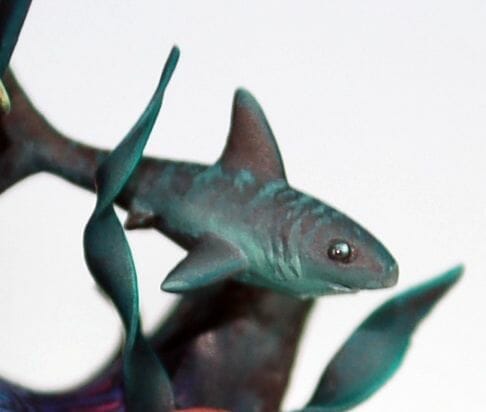

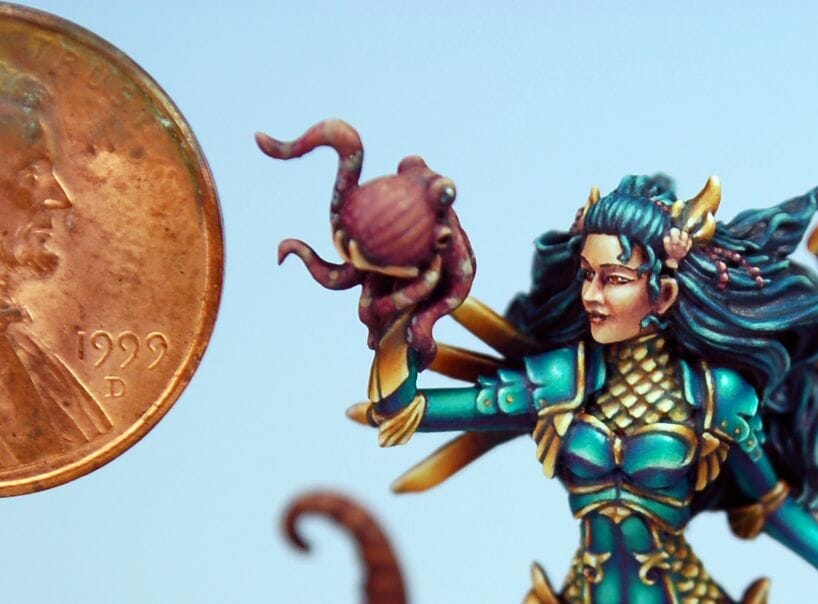
How do you varnish your miniatures?
I varnish all competition models with Testors Dullcote.
For army painting (tabletop stuff), gaming models, etc., I use Krylon Crystal finish for durability, but not for competition because it’s kind of glossy.
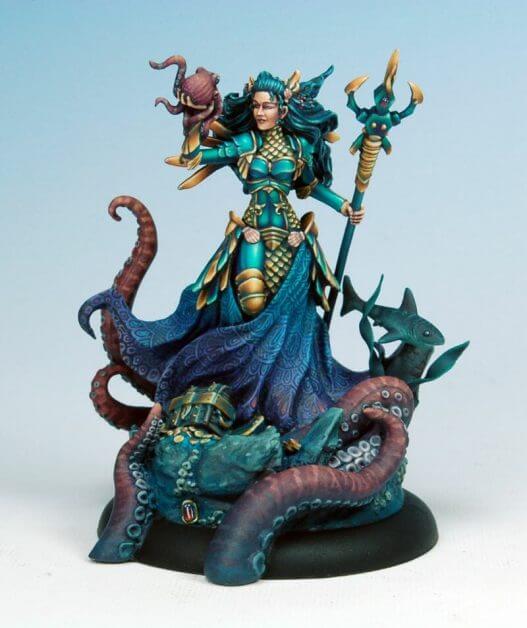
What’s it like winning a prestigious painting competition?
I was thrilled with winning. The Kraken Mistress win defended my title from 2011 and was one of my last main efforts before moving on to other endeavors.
Do you plan to enter competition again?
Maybe someday after I learn how to use an airbrush! I have plans to go to ReaperCon (one of my favorites), and the science art they let me do there is quite awesome! It’s great to be part of such a thriving community.
Conclusion
I’d like to thank Marike Reimer for sharing her time and expertise for this post.
If there was a single trait that threaded its way through Marike’s process that seemed (to me) to make the most difference for her success is perseverance. She was also willing to try out new things on-the-fly (even getting stuck for a bit) and incorporated critical feedback from different people.
I like to think people learn best with a multi-disciplinary approach, gaining experience through different perspectives. If you’d like to see more unique work and insights by miniature artists, check out these articles here and here.
For more of Marike’s work in action and to learn more, check out her Dark Sword Miniatures tutorial videos.
Happy Painting!



Tangible Day on YouTube (Miniatures and More!)


Pingback: Simple Tips for Fixing Photo "White Balance" (Easy Guide) - Tangible Day